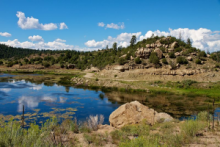Article
One of seven Native American tribes that share the Apachean, or Southern Athabascan, language. The Jicarilla Apache originated in Canada's Mackenzie Basin. Archaeological and ethnological evidence suggest that by the year 1400 the original Apache group had migrated south and began to separate into a few different tribes. By the time the Spanish arrived in the Americas, the Jicarilla people were settled in a large territory stretching over the Chama Valley of present-day New Mexico and eastward into Oklahoma. The Jicarilla Apache, through centuries of struggles over land against Spanish and then U.S. forces, have lost most of their territory. Today their reservation, which lies close to the eastern part of the Navajo Nation Reservation, occupies a small portion of northcentral New Mexico. In ongoing efforts to address the problems associated with loss of land, resources, and cultural heritage, such as poverty and crime, the Jicarilla Reservation government invests in retail and tourist enterprises, emphasizing active conservation of traditional arts, beliefs, and rituals.
"Dulce Lake, Jicarilla Apache Nation, New Mexico, August 6, 2010" by Christopher Nicol.
Manuscripts
References
Buskirk, Winfred
1986 Western Apache: Living with the Land before 1950. Civilization of the American
Indian Series. Norman: University of Oklahoma Press.
Goodwin, Grenville, and Janice Thompson Goodwin
1942 Social Organization of the Western Apache. Chicago: The University of Chicago Press.
Kaut, Charles R.
1957 Western Apache Clan System: Its Origins and Development. University of New Mexico
Publications in Anthropology. Albuquerque: University of New Mexico.
Tiller, Veronica E. Velarde
1992 The Jicarilla Apache Tribe: A History. Rev. ed. Lincoln: University of Nebraska Press.
Warren, Nancy Hunter., and Veronica E. Velarde Tiller
2006 The Jicarilla Apache: A Portrait. Albuquerque: University of New Mexico Press.

